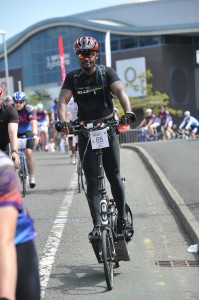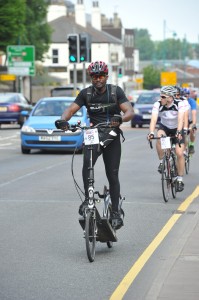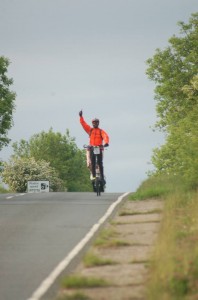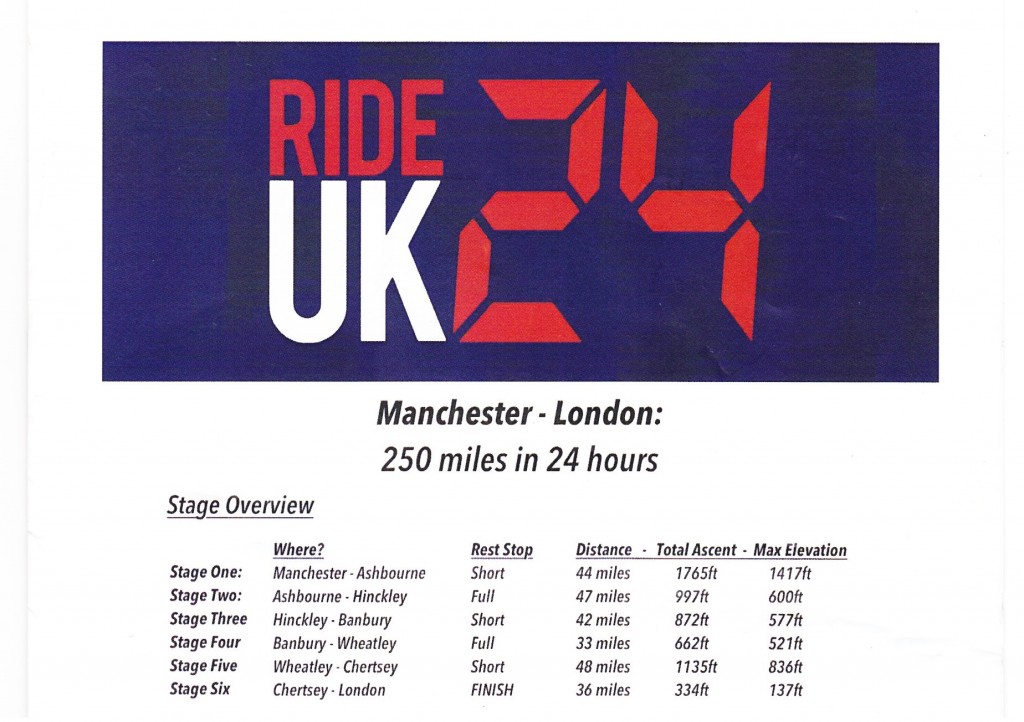Elliptical Cycling 24 hour World Record Attempt
By Idai Makaya
On 8th June 2013 I lined up my ElliptiGO 11R bike alongside a large group of long distance endurance cyclists at the National Cycling Centre in Manchester. We were awaiting the start of the Manchester to London Ride UK 24 endurance cycling challenge, a 250-mile time-trial event with a 26 hour time limit (and a 24 hour target finish time). This was to be my main ‘warm-up’ event before the 2013 London Edinburgh London Audax (LEL 2013), which was to be my primary ElliptiGO ultra-endurance cycling challenge for 2013.
Taking place from 28th July 2013 to 2nd August 2013, LEL is a continuously-timed ultra-distance cycling challenge covering the 887-mile (1418km) distance from London to Edinburgh and then back to London again (all within a 116-hour and 40 minute time-limit). It is the premier long distance cycling event organised by Audax UK (the UK long distance cycling association) and is held every four years. I believed the LEL challenge, being the longest amateur road cycling event in Europe, would present an ideal opportunity to demonstrate that there’s no road cycling challenge which can’t be successfully completed on an ElliptiGO bike.
Many ultra-distance cyclists will agree that developing the fitness to cover 250-miles (400km) in under 24 hours is a reasonable benchmark to achieve prior to tackling a multi-day endurance cycling event like LEL. So I chose to rely on the same performance benchmark – even though covering the 250-mile distance within 24 hours would not only represent a significant personal best for me, it would also be a new ElliptiGO 24 hour distance World Record. Because no ElliptiGO rider had taken on a challenge as long as LEL (and within such tight time limits), I had no previous training history to go on when planning my own attempt. Thus, I needed to make a number of training judgements based purely on what I believed were rational calculations and logical training algorithms.
These training judgements were based loosely on what cyclists would do when training on road bikes for a similar event – but with a weighting for the 30-50% extra effort used by an ElliptiGO rider to cover the same terrain (and with a leaning towards a Minimalist training regime, designed to produce the best fitness gains from the least training input – through rational manipulations of training intensity). My general endurance fitness regime at this point in the training cycle was based loosely around three weekly training sessions – namely a medium distance easy session, a medium distance hard session, and a long distance moderate session (approximating to about 140-miles of total weekly riding).
Ride UK 24:
When the starting horn was finally sounded to commence Ride UK 24, after a dramatic countdown, we had all left the National Cycling Centre together and the large group had slowly spread out into the heavy Saturday morning Manchester traffic. There were a number of rather unfortunate ‘road rage’ incidents between a few of the cyclists in our large group and some impatient motorists going along the Manchester city centre stretches (which made up the first 10-miles of the course). We barely averaged 10 mph getting out of Manchester, largely due to the numerous traffic light stops and intersections. I suppose the city centre wasn’t the ideal place to have such a large group of riders moving about – but some of the motorist behaviour was really poor, even under those circumstances…
We had branched off the A5 route on the outskirts of Manchester after about 10-miles of slow riding and begun heading towards the Peak District, where we were soon confronted by a series of very long (but manageable) climbs. One of these stretches involved a  sustained 5% ascent for 8-miles; unbroken. The cyclists were spreading out by this stage and I was happy with my pace and with how I had felt at the time. I recall the scenery was very pleasant in the summer sunshine.
sustained 5% ascent for 8-miles; unbroken. The cyclists were spreading out by this stage and I was happy with my pace and with how I had felt at the time. I recall the scenery was very pleasant in the summer sunshine.
The checkpoints were all about 40-45 miles apart on the event and we had to be scanned at each one, in order to record our time splits. At the first checkpoint I had met a few of the lead riders on their road bikes, they were leaving just as I arrived. I was surprised by how many riders were hanging about resting at the first checkpoint. I suppose the miles of climbing in the Peak District were getting to them already.
It was a nice warm day with a gentle breeze and I had found myself drinking about a litre of energy drink with every hour of riding that passed in the warm sunshine – which was something of a surprise. The scenery was beautiful and I kept my promise to myself to enjoy the first 150-miles of the ride and take in as much of the views and of the experience as I could, whilst awaiting the inevitable onset of fatigue in the later stages of the event.
In the second segment of the ride I was riding steadily, but not very fast – much as I would expect to ride in LEL. The key thing I wanted to practice for LEL was minimising the stops and to keep any stops as brief as possible. That was allowing me to stick just behind the middle group of road bikes, because the bulk of cyclists were riding in packs and going quite swiftly between checkpoints – but resting for very long periods at each checkpoint. So I was catching up with them at each checkpoint and leaving before they did – and it was taking them about an hour to catch up with me and pass me again before the next checkpoint.
This pattern went on throughout the afternoon and into the evening. It was summertime and the daylight visibility had persisted until about 10pm, when I first switched on my  headlight. Between 8pm and 10pm I had used a simple flashing headlight to make myself visible to the motor vehicle traffic, but I had preserved the main headlight battery for true darkness. I also donned a high visibility but lightweight jacket at the 90-mile checkpoint, in order to become more visible as the sunlight had begun to fail.
headlight. Between 8pm and 10pm I had used a simple flashing headlight to make myself visible to the motor vehicle traffic, but I had preserved the main headlight battery for true darkness. I also donned a high visibility but lightweight jacket at the 90-mile checkpoint, in order to become more visible as the sunlight had begun to fail.
I had found my legs were quite tired by the time we had ridden the first 80-miles, due to the unexpected climbing along that first part of the route. It may have been the hilliest 80-miles I’d ever ridden, up to that point. My eyes had started itching in the late afternoon, due to hay-fever. This had started from about 90-miles in – and I had initially feared at the time that those were the first signs of ‘hitting the wall.’ But I had felt more normal later on, which suggested the eye problems were due to hay fever – or salt and sunscreen getting into my eyes from sweating.
As I reached more familiar ground – around Warwickshire and Rugby, not too far from my normal long distance training grounds – it had lifted my spirits a lot. I was still enjoying the ride, although I had made a small mistake at around 8pm, which made the next 8 hours rather uncomfortable. I had a new waist-belt for my food provisions, which I was trying out for the first time (the intention being to allow me to eat on the move without stopping) and at the final daylight checkpoint I’d tightened it a little because it had felt like the straps were loosening around my waist.
That slight tightening had eventually led to me developing mild nausea, which had continued to get progressively worse for the next 8 hours, until I had eventually figured it  out (at around 4am the next morning) at one of the checkpoint stops. That nausea problem could have ruined my event – and I did actually toy with the idea of forcing myself to vomit in order to ease the nausea at one point. So a lesson had been learned (this was my first ever ride with the waist belt, which was not good practice when bringing in something new – but it was better learned in the practice event than during LEL). As soon as I had loosened the waist-belt the nausea had gradually subsided and faded away, allowing me to eat more easily.
out (at around 4am the next morning) at one of the checkpoint stops. That nausea problem could have ruined my event – and I did actually toy with the idea of forcing myself to vomit in order to ease the nausea at one point. So a lesson had been learned (this was my first ever ride with the waist belt, which was not good practice when bringing in something new – but it was better learned in the practice event than during LEL). As soon as I had loosened the waist-belt the nausea had gradually subsided and faded away, allowing me to eat more easily.
The night segments of the ride were fascinating, as I got used to navigating in a halo of light provided by the headlight. I was surprised at how safe it actually felt. I was initially concerned about riding through the night on a Saturday night, but when darkness had actually fallen I soon realised how easy it was to detect approaching cars. In the complete silence and complete darkness you can detect any light or sound much earlier than you would during the day.
Late night traffic is sparse out in the countryside and I could ride in the middle of the lane most of the time, meaning there was little risk of hitting potholes or going off the road. It felt a lot safer than I had expected – and no less safe than riding during the day – which was a nice discovery.
I kept my rolling average speed (the average speed when I was moving, excluding any stops) at between 12 mph and 12.4 mph. It took me over 70-miles to achieve a 12 mph moving average, due to the slow start in Manchester and all the climbing in the aptly named Peak District. But once I got the average pace above 12 mph it had remained there for the rest of the ride – oscillating between 12.3 mph and 12.0 mph moving average speed. Short pit-stops helped keep the overall average speed at around 11 mph and I definitely felt this would be achievable during LEL, where the daily distances should not exceed 180-miles.
At the final checkpoint, with just 37-miles remaining before the finish in East London, it was already well into daylight and I was feeling upbeat, after a bit of a downward spiral in my mood during the period between 2am and 5am. I believe that was linked to natural sleep cycles and I knew this would be a challenge to master during LEL.
 I had noticed just before the final pitstop that the ElliptiGO’s chain was becoming very loose and was at risk of coming off, if I was to hit a bad road surface. Luckily, I had met Gary, the roving event mechanic on this event (one of Britain’s best bike mechanics). He’d ‘bailed me out’ when I had the puncture at Ride 24 the previous year – and ‘chipped’ in again at this point and adjusted the wheel for me to tighten up the chain. I had indulged in some soup and salty crisps, which were a huge relief to my stomach and digestive system after 18 hours of eating mainly chocolates and biscuits.
I had noticed just before the final pitstop that the ElliptiGO’s chain was becoming very loose and was at risk of coming off, if I was to hit a bad road surface. Luckily, I had met Gary, the roving event mechanic on this event (one of Britain’s best bike mechanics). He’d ‘bailed me out’ when I had the puncture at Ride 24 the previous year – and ‘chipped’ in again at this point and adjusted the wheel for me to tighten up the chain. I had indulged in some soup and salty crisps, which were a huge relief to my stomach and digestive system after 18 hours of eating mainly chocolates and biscuits.
I had realised during this event that my biggest challenge during LEL would probably be finding a way to eat enough calories without sitting down for time-consuming meals at the checkpoint controls. Time spent not moving is the biggest ‘enemy’ of any long distance cyclist and an ElliptiGO rider has to solve this problem out of necessity. I needed to keep my stops minimal and brief in the Manchester to London ride if I was to break the 24 hour barrier for the full distance – and that meant eating on the GO (which had meant snacking on sugary snacks most of the time).
The final stretch into London had seemed to take an eternity. I’d lost some time at the final pitstop during the bike repair – partly because the soup took so long to finish (the soup was nice, but very hot)! There was still a lot of hill climbing to do as we got closer to London and we were riding into a headwind, which was slowing us down somewhat. The guys on road bikes were picking up the pace in this final stage and I couldn’t stick with them on the ElliptiGO – so I had just let them go past.
I think I was still on track for a sub-23 hour finish at that stage. But getting into London there were problems with the route markings. Some arrows were missing and some of the roads had been barricaded – unexpectedly – including The Mall at Buckingham Palace. The event organisers had wanted to take us on a tour of London during this final stage – but on a busy Sunday morning, full of tourists, it had turned out to be a bad idea. I actually got lost a few times, but did not ever wander far off the course. I had to stop and call the control centre for directions a few times – and sometimes I had retraced my steps to find the last direction arrows I’d seen – and that all delayed me quite a bit.
As mentioned, I had managed to get myself lost again at Buckingham palace on The Mall, which was barricaded. I again phoned the control centre and was directed to retrace my steps, at which point I had met a pair of riders who had tracked along with me from about 100-miles into the event until the final checkpoint. It turned out that one of them knew  London really well and he had directed us through the difficult parts where the route signs were missing – and the parts with no signage at all – until we had reached Hackney Marshes for the finish.
London really well and he had directed us through the difficult parts where the route signs were missing – and the parts with no signage at all – until we had reached Hackney Marshes for the finish.
Having him around had really helped and had kept me on course – although I had had to charge really hard to keep up with those guys once they had caught up with me. They were using the speed and lightness of their road bikes to good effect at this point as they sped up for the finish. I think we had averaged about 14 mph for the final 10 miles through Central London to the finish – impressive in view of the number of traffic light stops we had and the heavy Sunday traffic.
The Outcome:
I got to the finish line in 23 hours and 20 minutes (for about 250-miles of riding). It was a new Elliptical Cycling 24 Hour Distance World Record and I had confirmed that I had built up the fitness required to cover 250-miles (400km) within a single day – an important performance indicator in my journey towards taking on the much bigger challenge of riding LEL at the end of July 2013….
The final event statistics, taken from the event website, were as follows:
- The cyclist to complete the challenge in the shortest amount of time did so in an impressive 20 hrs 41 mins.
- 129 out of 141 cyclists managed to complete the challenge in under 24 hrs.
- The cyclist to endure the challenge for the most amount of time, was out on the course for 26 hrs 26 mins.
- Only five women took on the challenge.
- One challenger, Idai Makaya, completed the entire course in under 24 hrs on an ElliptiGO bike.


